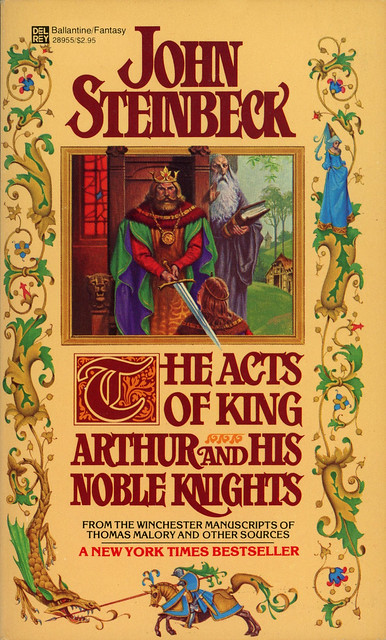Just like East of Eden , John Steinbeck wanting to write for his , and others, Children a tale that would impart the tender values , upbringing and sense of duty , honour , keeping pledges , delivering on words with actions that he grew up on as the young child.The work that opened his eyes as a child was an archaic Malory version of The legendary adventures of King Arthur and his Knights.
Initially , Steinbeck looked to make a translation of the Malory stories replacing older words which would in his view be an obstacle for Children with more common ones to enable fluidity and the story to run along at a uniform pace.Very early on in the work he realised the work of Malory was cumbersome , got bogged down on long lists of participants , and dwelt on epic battle scenes whilst forgetting to return to missing threads in the plot.This meant Steinbeck would have to spend a longer than expected devotion to the research , detail and fusion of the plot.
This article gives an excellent introduction of the considerable details of deep research ( a lot of it in England) , careful detailing of original manuscripts , and steadfast focus Steinbeck gave the project over many years.
Read this novel to your children, read it to yourself, whatever you do, read it. It is magic, it is wonderful, but more importantly it carries with it a wide-eyed, childlike sense of wonder about the world, something which has never been more lacking than today.
Many have speculated why he did not manage to finish the project.The most reasonable explanations are that he , sensing the very chivalric values he held so dear , got diverted from a detailed study that would involve a lot of travelling to europe for a project that would entail a re-telling of the tales rather than the initial idea of a translating at a time in which he thought he was close to death.At this time the concerns of his legacy to his children and their peers was the urgent loss of decency in morals of society closer to home which inspired the Books "Winter Of Our Discontent" and shortly afterwards by "Travels With Charley: In Search Of America".Shortly afterwards the Winning of the Nobel Prize , and the irony of one of the Sons he was writing the project for Participating in the Vietnam War , with all the intendent criticism of a letting down of his liberal values of previous years meant he could not give it the attention required as well as the initial goal being lost.
Steinbeck’s retelling is clearly a labor of love, unfinished as it may be. His language is powerful and aesthetically pleasing, the stories are exotic and full of adventure, the characters and broad strokes are beloved and familiar. When Steinbeck prefaces the chapter “The Noble Tale of Sir Lancelot of the Lake” with the simple, blunt remark, “And noble it is,” he gets at why we want to read these stories—or why we should want to, or why we should read them. They are just plain good, and he is good at telling them, and I wish he had managed to put his stamp on the whole thing.
The above quote comes from this article which explores more themes and working processes of Steinbeck during this endeavour.
One of the best features of the Book is the appendix of letters written by Steinbeck to his Agent in which we get the sense of his creative process and how much effort and diligence go into even the most casual seeming passages of his work. Lastly , here is a beautifully arranged tribute song to the writer himself.






